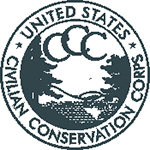History of Cherry Springs State Park
Early Settlers
During 1818, Jonathan Edgcomb made his second try at settling in the wilderness of Potter County.
Along the Jersey Shore Pike, Edgcomb constructed a log house that became known as the Cherry Springs Hotel. The hotel was in an extremely remote spot and for years the only visitors, other than travelers on the pike, were wandering American Indians.
Over the years, the pine and hemlock in the Cherry Springs area was lumbered off and in their place grew hardwood trees like sugar maple and the park’s namesake, black cherry.
Civilian Conservation Corps Era

The Cherry Springs Civilian Conservation Corps (CCC) Camp, S-136-PA (1936), was one of ten CCC camps constructed in the Susquehannock Forest District.
A forester directed the work to be done at each camp, such as clearing underbrush, opening trails, and constructing buildings and roads.
Additionally, Camp Elliott (named for District Forester Harry Elliott) was set up at Cherry Springs.
This camp was not connected with the CCC camps, but was under the supervision of the former Department of Forests and Waters. Unemployed college boys stayed at this camp, and one of their accomplishments was to construct the 40-acre airfield at Cherry Springs (under the former State Bureau of Aeronautics) during the summer of 1935.
The Second International Dark Sky Park in the World
During 2008, Cherry Springs State Park attained a Gold Level International Dark Sky Park certification from the International Dark Sky Association. Cherry Springs was, in fact, the second International Dark Sky Park in the world.
The International Dark-Skies Association and its partners certify locations with exceptional nightscapes as International Dark Sky Parks (IDSP).
These locations serve as reminders that with quality outdoor lighting, the extraordinary wonders of the nighttime sky and night environment are just as much a part of our lifestyle and history as are the daylight hours. In fact, without the inspiration and wonders of the nighttime environment much of the world's history, art, culture, music, and literature might not have been created.
What is Light Pollution?
Just as garbage can make a picnic ground less useful for picnicking, so light at night can make stargazing less productive by making it impossible to see faint astronomical objects. Light pollution is light that makes the night sky less dark and less useful for seeing celestial objects.
Light pollution limits:
The visibility of the Milky Way to the unaided eye
The visibility of nebulae and galaxies seen in telescopes
The quality of astrophotography
Low light pollution conditions, or dark skies, are one of the most important properties of a good astronomical observation site.
Why Cherry Springs State Park?
During 1998, Cherry Springs State Park was listed on Phil Harrington's Dark Registry (an astronomy internet site); a place that lists the darkest skies in the state. The description noted the site had a 360-degree view and "No light pollution sky glow … none in all directions."
Several independent astronomers began using the park for observing the night sky.
Cherry Springs State Park became the location for the Black Forest Star Party in 1999. This annual event draws hundreds of amateur astronomers to come together and explore the dark skies of Potter County, Pennsylvania.
During 2000, DCNR declared Cherry Springs State Park the first Dark Sky Park in the commonwealth.
During 2002, the Stars-N-Parks program began providing free astronomy programming to the public and the Cherry Springs Dark Sky Fund was created in conjunction with the Pennsylvania Parks and Forests Foundation.
The 2003 cover for the Potter County Visitor Association visitor’s guide featured the Aurora Borealis over Cherry Springs. This cover and the slogan “Potter County, Pennsylvania’s Star Gazing Capital” continues to be a key to the “untouched, unspoiled” tourism theme that defines Potter County tourism.
Late in 2003, DCNR launched the Pennsylvania Wilds conservation landscape to encourage the growth of tourism and related business in a 12 county area of north central Pennsylvania.
During December 2004, as part of the Pennsylvania Wilds initiative, Fermata Inc. completed the Early Implementation Conceptualization plan for Cherry Springs State Park, entitled Pennsylvania Wilds Dark Skies. This document recognized Cherry Springs as a model site for viewing/photographing the sky within the Pennsylvania Wilds. It also outlined a strategic plan for developing and enhancing the night sky recreation infrastructure, programming, and staffing needs.
During June 2008, Cherry Springs State Park was designated as a Gold Level International Dark Sky Park -- which is the highest designation given to a dark sky site.